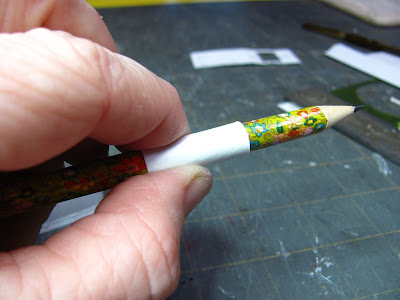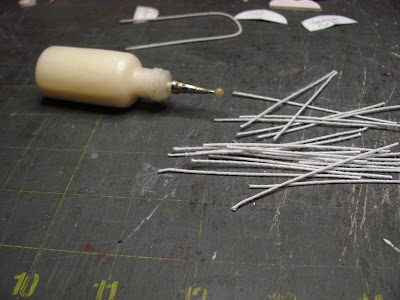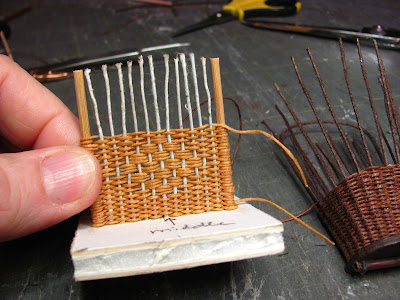I've been wanting to make one of these forever. If you are new to miniature weaving read the tutorials: How to make a 1 inch scale wicker table and faux tile top and Wicker Chair. You will find them in the "Things to do, Things to see" list at the left of the blog.
This is my finished version of the wicker grocery cart.
I made the wheels first.
I used 1/16 inch and 1/4 inch punches.
I punched the 1/16 hole first in card stock. Center the 1/4 inch punch over the 1/16 inch hole and punch, leaving what you see on my table.
Punch out 6 of these.
Glue 3 punched circles together for each wheel.
You can use yellow carpenter's glue or tacky glue.
Cut a strip of paper 1/8 wide or use quilling strips like I did.
You might have to glue two strips together to get a wheel a 1/2 inch in diameter.
For wrapping the strip I used a large needle with the pointed end pushed into a wooden dowel.
The tip of the eye is snipped off.
The end of the strip is slipped into the eye and you start rolling the paper around.
Roll the strip until it's a 1/2 inch in diameter.
Glue the end of the strip to the roll.
Use tweezers to pull out the center of the roll.
Like this.
Pull out enough so that the punched circles will fit.
Glue the punched circles into the rolls.
Print Nancy's patterns onto card stock.
Trace the patterns onto mat board. I have glued my mat board together, I will cut them out on the scroll saw.
You can trace the patterns separately onto mat board. Cut the pieces out and glue the 2 bottoms together and glue the 2 handle forms together.
It's easier to drill if I use a "T" pin to mark the holes.
My drill bit has somewhere to start.
I find it easier to drill before I cut out the small pieces.
The drill bit I am using is the diameter of 26 gauge covered wire. My bit did not have a number on it so I can't tell you its size.
When you review the tutorial on weaving the wicker chair I explain about the covered wire and waxed linen that I will be using here. That tutorial is full of information and will answer your questions. I am always available at
camceiling@frontiernet.net to answer any questions you might have.
I have marked two holes that are drilled with a larger bit.
These holes are for the 20 gauge covered wire.
The handle form and the bottom have been cut out.
Mark the center of the handle form.
Very important: After all of your wire is cut glue both ends to seal the threads. If you don't do this you will never get the wire into the holes you've drilled into the mat board.
Cut a piece of 20 gauge covered wire 14 inches long.
Mark the center.
Bend the wire over the form keeping the centers together.
Mark where the form ends. This is where you will stop your weaving.
Measure from the end of the form mark, 2 inches and mark.
From 26 gauge covered wire cut a piece 3 1/4 inches long.
Mark 1/4 inch from one end.
Set aside for now. This is the middle stake, the one that has the stub on the bottom front of the cart.
This next bit is going to be difficult, you will need your needle nose pliers.
Sometimes I photograph the process while I am making the first what ever I'm making. Sometimes I make a prototype to see if what I think is going to work will work. Sometimes I change things as I am working, this is what happened here.
I placed my wheels more toward the front of the cart, I don't like the look. I decided to change the method on your tutorial and keep weaving my cart.
If this method proves too difficult for you I have the instructions at the end of this tutorial for the easier method.
Put the handle into the bottom at the 2 inch marks.
I am gluing here but you really don't need to.
This is a coffee stirrer, a narrow straw or tube. Some hairsprays have a narrow tube that you can use, too. This tube will hold the toothpick axle for your wheels.
Trim the tube to the width of the bottom of the cart.
This is the difficult bit.
Keeping the 2 inch marks level with the bottom, bend the rest of the wire into the next hole.
Use your needle nose pliers. Insert the tube into the loop that the wire has made. Pull the wire tightly, not so tight that it changes the shape of the tube.
This is what you should have.
Another view.
Get that piece of 26 gauge wire and glue it into the center hole of the front bottom. Leave a 1/4 inch of the wire sticking out from the bottom of the cart.
This is a reminder to glue the tips of the wires.
Cut 18, 26 gauge wires, 3 inch long.
Take some time out to paint your wheels any color you like.
I spray painted my wires brown because I am going to weave with walnut brown waxed linen.
Painted.
Remember, I changed the way I made the cart so you see the handle in this picture.
You can also hand paint the wires to match your waxed linen or painted crochet thread.
Glue all the wires in. Leave these to dry. I like to leave them over night.
Again, if you follow the tutorial you will have a tube connected to the bottom of the cart and the stub in the front of the cart.
I pushed out the wires on the front of the cart.
We will keep an eye on those wires as we weave.
This is the waxed 3 ply linen I am using to weave the cart.
I thought I had this terrific idea of having the handle start at the bottom, go around the top and end on the other side.
We can't use the linen from the spool without cutting it into lengths, sorry.
I cut my lengths about 36 inches long.
Leave a tail of the linen inside on the bottom to start weaving.
Start at the handle and begin weaving over and under all around.
Weaving.
When I get to the back corners, the handle, I will double wrap IF I am weaving under the handle.
IF I am weaving over the handle I just weave over without double wrapping.
Adding a new piece of linen.
When you are on the back and you're getting short, weave under and leave a loop. Stick a new piece of linen into the loop and pull to tighten. Leave the old piece for a few rows and then snip off close to the weaving.
Go on weaving with the new piece.
This is how it should look.
Looking at the inside.
If you've done your homework you will recognize this as the trial diamond we made for the wicker chair tutorial.
I want to put a diamond on the front of my cart.
I will start the diamond after weaving about 7/8 inch.
My diamond will only have 3 patterns across at its widest point, it won't be this big.
My basket measures 1 1/4 inches out to the front measuring from the back. The weaving follows the the slant of the handle on the sides.
I'm done weaving the basket part.
I'm putting the handle form up to the back of the cart to check for height.
I'm done.
Trim off the extra wire.
Be careful, don't cut off the handle.
Now, to start wrapping the handle.
Wrapping.
When I get to the end I thread a large eyed needle to bury the linen in a few rows. Trim extra linen.
For finishing the top and bottom I make a braid from the waxed linen. Cut three pieces of linen 26 inches long. Fold each piece in half.
I make an overhand knot at the folded ends, secure that end on a hook or tape it to your table top and braid to the end.
This is my braid. You should have enough for top and bottom.
Use tacky glue to glue the braid to the top and bottom of the cart.
Bottom braid glued on.
Glue one wheel onto a toothpick.
Put the toothpick into the tube and slide the other wheel on. You may have to sand the toothpick a little to get the other wheel to slide on.
Glue the wheel on and trim off the extra toothpick.
I painted the end of my toothpicks red.
Here's the other way to put the tube onto the cart.
I've cut a piece of 20 gauge wire long enough to have 2 1/4 inches beyond the handle form on each side.
I've glued it into the bottom.
When drilling, only drill the corner holes larger for the handle.
Cut 2 wires 7 inches long from 26 gauge wire.
Fold the wires in half.
Insert the wires into the first two holes after the corner handles.
After cutting the tube, insert the tube into the loops of the wire.
This is how my cart was made.
You won't need your pliers.
Finally, I have my wicker cart! I hope you find some time over the holidays to make some minis.
Happy Thanksgiving!!
Have fun, Expand on it, Make it better . . .
Just Keep Making Minis!
TTUL
Kris
Speaking of wicker, Debbie send me a picture of what she's been up to . . . .
Busy girl! Love the bold color of waxed linen she used. Look at all the geraniums.




































































































